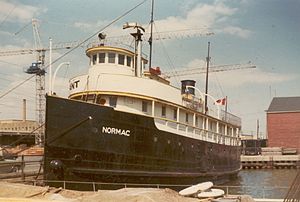
Georgian Bay is a large bay of Lake Huron, in the Laurentia bioregion. It is located entirely within the borders of Ontario, Canada. The main body of the bay lies east of the Bruce Peninsula and Manitoulin Island. To its northwest is the North Channel.
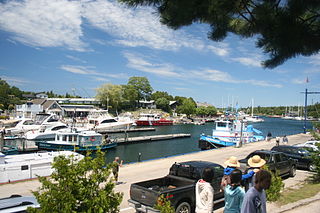
Tobermory is a small community located at the northern tip of the Bruce Peninsula, in the traditional territory of the Saugeen Ojibway Nation. Until European colonization in the mid-19th century, the Bruce Peninsula was home to the Saugeen Ojibway nations, with their earliest ancestors reaching the area as early as 7,500 years ago. It is part of the municipality of Northern Bruce Peninsula. It is 300 kilometres northwest of Toronto. The closest city to Tobermory is Owen Sound, 100 kilometres south of Tobermory and connected by Highway 6.
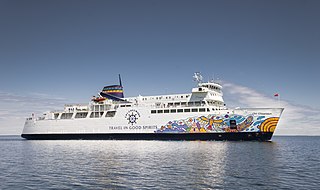
MS Chi-Cheemaun is a Canadian passenger and vehicle ferry in Ontario, Canada, which traverses Lake Huron between Tobermory on the Bruce Peninsula and South Baymouth on Manitoulin Island. The ferry connects the two geographically separate portions of Highway 6 and is the vessel that replaced MS Norgoma and SS Norisle in 1974. The ferry service runs seasonally from mid-May to mid-October. As of 2022 she is the third largest passenger vessel sailing the Great Lakes after the expedition cruise liner Viking Octantis and the US ferry SS Badger, although several larger vessels previously serving the Great Lakes are still in service in other parts of the world.
King's Highway 6, commonly referred to as Highway 6, is a provincially maintained highway in the Canadian province of Ontario. It crosses a distance of 480 km (300 mi) between Port Dover, on the northern shore of Lake Erie, and Espanola, on the northern shore of Lake Huron, before ending at the Trans-Canada Highway (Highway 17) in McKerrow.

MS Norgoma was a Canadian package freighter and passenger ferry, that could also transport automobiles on a limited basis. Originally constructed as a steam-powered ship in 1950, SS Norgoma primarily sailed the route from her home port of Owen Sound to Sault Ste. Marie, providing a five-day round trip, once a week, serving isolated communities along the north shore of Lake Huron. After conversion to a motor ship, Norgoma was transferred to the popular Manitoulin Island ferry route between Tobermory and South Baymouth along with her sister ship SS Norisle, replacing the smaller ferry, MS Normac, on that route.
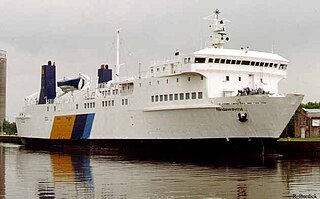
The MV Manx Viking / Nindawayma was a passenger, truck and car ferry, whose last active service was on Lake Huron, operated by the Owen Sound Transportation Company; under contract to the Ontario Ministry of Transportation. In Canadian service she served the Highway 6 route between Tobermory and South Baymouth, Manitoulin Island from 1989 to 1992 alongside the MS Chi-Cheemaun.

Captain John's Harbour Boat Restaurant was a restaurant and banquet hall in Toronto, Ontario, Canada. For most of its existence it was located in the MS Jadran, a former Adriatic passenger ship that was permanently docked at the foot of Yonge Street at 1 Queens Quay West on Toronto's waterfront. The ship was moored off on a small laneway at the foot of Yonge Street called Captain John's Pier. Once a prestige destination, the restaurant was open every day of the year, including all major holidays such as Christmas and New Year's Day, for almost 40 years. When it opened, the waterfront was an industrial portland. The Harbourfront redevelopment turned the area into a recreational destination for residents and tourists and a residential neighbourhood; Captain John's helped begin a gentrification process that ultimately claimed it as a victim.
Russel Brothers Limited was a Canadian steel boat builder, diesel engine manufacturer and steel fabricator. The company operated in Fort Frances, Ontario from 1907 to 1937 and then in Owen Sound, Ontario from 1937 to 1994.

The Owen Sound Transportation Company, Limited was the forerunner of the enterprise that currently operates the vehicle and passenger ferry - M.S. Chi-Cheemaun - between Tobermory on the Bruce Peninsula, and South Baymouth on Manitoulin Island. For updated information, see the article on the M.S. Chi-Cheemaun.

SS Norisle is a Canadian steam-powered automobile ferry that sailed the route between Tobermory and South-Baymouth Manitoulin Island alongside her sister ships, the MS Norgoma and the MS Normac, owned by the Owen Sound Transportation Company Limited.
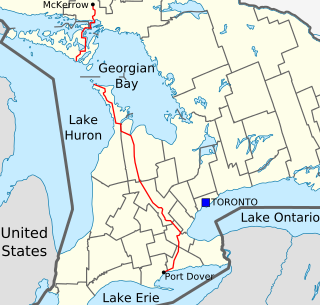
King's Highway 68, commonly referred to as Highway 68, was a provincially maintained highway on Manitoulin Island, linking the island to the mainland. It was connected to the rest of the network at McKerrow, where it met Highway 17. The road was built in the 1920s as a trunk road for the Department of Northern Development, but was assumed as a provincial highway in 1937, as the only King's Highway on the island. Highway 68 stretched from South Baymouth in the south, through the towns of Manitowaning and Little Current north through Espanola on the mainland, before terminating at Highway 17 in McKerrow.
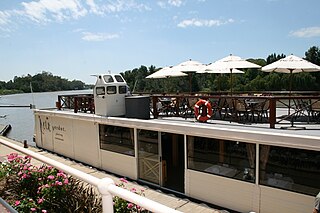
A floating restaurant is a vessel, usually a large steel barge or hulk, used as a restaurant on water. The Jumbo Kingdom, formerly located at Aberdeen in Hong Kong, was at one time the world's largest floating restaurant, until it sank at sea in 2022. Sometimes retired ships are given a second lease on life as floating restaurants. The former car ferry New York, built in 1941, serves as DiMillo's in Portland, Maine. Another example is the train ferry Lansdowne, which served as a restaurant in Detroit. Plans for Lansdowne to continue in this capacity on the Buffalo, New York waterfront came to naught and it was scrapped in the summer of 2008. A third example of a ship's hull converted for this purpose is Captain John's Harbour Boat Restaurant in Toronto, which was located on MS Jadran, a former Yugoslavian ship but has since been closed and scrapped. Normac, the first Captain John's restaurant, was moved to Port Dahousie as the floating cocktail lounge Big Kahuna and is now the Riverboat Mexican Grill.
Port Weller Dry Docks was a shipbuilder on the Welland Canal at the Lake Ontario entrance. The shipbuilder was founded in 1946 and the site was initially owned by the Government of Canada for storage purchases. The shipyard expanded to include ship repair, and reconstruction work. In 1956, the drydock was sold to the Upper Lakes Shipping Company, which began the construction of vessels at the site. The shipyard twice went insolvent, most recently in 2015. Port Weller Dry Docks was used to build, refit and repair cargo vessels.
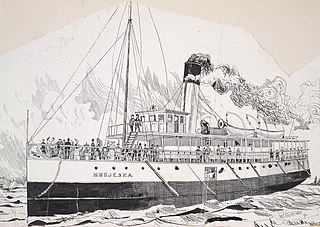
SS Manitoulin was a Great Lakes passenger steamship. She was built in 1889 as Modjeska, and renamed Manitoulin in 1927 after a major refit. She was laid up in 1949 and scrapped in 1953.
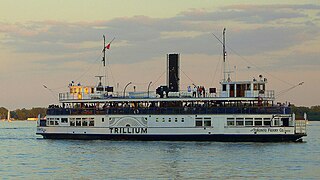
Trillium is a side wheeler ferry operated by the City of Toronto Parks, Forestry and Recreation, in Toronto, Ontario, Canada. Now 113 years old, she is one of several Toronto Island ferries operating between the Jack Layton Ferry Terminal at Bay Street and Queens Quay and three landing points on the Toronto Islands. She is the last sidewheel-propelled vessel on the Great Lakes.
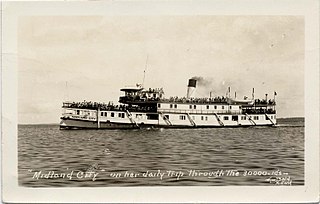
SS Midland City was originally a Canadian side-wheel steamboat that provided passenger and cargo transportation on the Great Lakes from 1871 until 1955. Originally named Maud, then America, she underwent several extensive refits over her 84-year service, and saw several owners. The ship was intentionally run aground and burnt to the waterline in 1955 near the mouth of the Wye River in Midland Bay. The wreck is intact and visible above the water to this day, where it acts as a breakwater for the Wye Heritage Marina and local attraction.
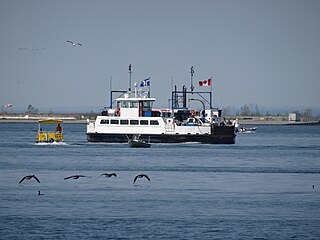
The Ongiara is a 59-year-old Toronto Island ferry operated by the Parks, Forestry and Recreation Division of the City of Toronto government. The ferry serves the Toronto Islands from a dock at Jack Layton Ferry Terminal in downtown Toronto, Ontario, Canada.
